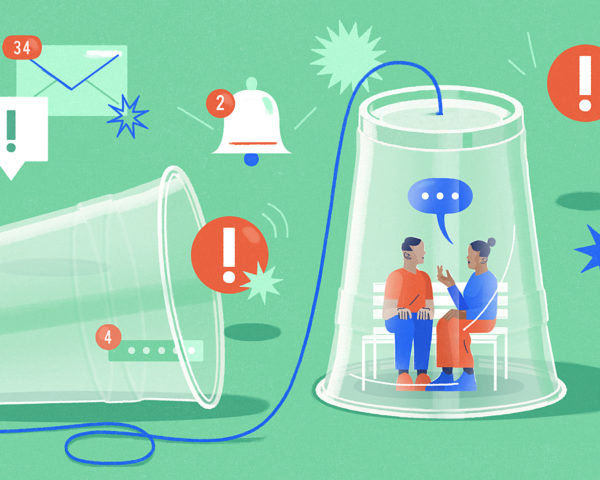5-Second summary
- Psychologically safe work environments allow team members to feel that they can safely take calculated risks without fear of repercussions.
- A lack of psychological safety may deter people from speaking up about mistakes, knowledge gaps, or potential problems.
- When working remotely, you can promote psychological safety by being intentional about scheduling one-on-one meetings, asking open-ended questions, modeling boundaries, and setting expectations for video meetings.
Psychological safety. By now, every leader has been conditioned to want it on their team, but many still don’t understand what it is — let alone how to cultivate it. In fact, recent McKinsey research shows that only 26% of leaders display behaviors that instill a sense of psychological safety at work.
Despite being coined in the late 1990s, the term has achieved buzzword status in recent years. And while it’s often used as a shorthand for “healthy work culture,” the true meaning of psychological safety is a little more precise – it’s a crucial aspect of good team culture, but not the entirety of it.
So what exactly is psychological safety in the workplace? Why does it matter? And as a leader, what can you do to make sure your team feels it?
What exactly is psychological safety?
Look in five different places and you’ll find five slightly different ways to define psychological safety.
Amy Edmondson, the Harvard researcher who first used the term in 1999, describes it as a “shared belief held by members of the team that the team is safe for interpersonal risk-taking.” McKinsey says it’s the “absence of interpersonal fear.” The American Psychological Association says it’s the “ability to freely express your opinions at work without fear.”
All of those are correct, driving towards the same psychological safety definition. When a team is psychologically safe, members all feel comfortable doing any or all of the following without fear of judgment, humiliation, or repercussions from their leaders or colleagues:
- Taking risks
- Sharing bold ideas
- Failing or making mistakes
- Delivering bad news
- Asking questions
- Requesting help
- Expressing opinions
- Vocalizing concerns
In short, rather than swallowing their suggestions or sweeping their shortcomings under the rug, individuals feel empowered to, well, be human at work. They have the confidence that their manager and team members will support them, regardless of the outcome.
What are the four factors of psychological safety?
It seems like a deceptively simple concept on the surface: make sure your direct reports feel safe, secure, and supported. Easy enough, right?
In reality, it can be tricky to cultivate and maintain — which is why many leadership experts have developed systems and models to simplify the concept. The four factors of psychological safety, created by Dr. Timothy R. Clark, is one of the more popular frameworks that breaks down four stages of psychological safety:
- Inclusion Safety: Team members feel safe to be their authentic selves
- Learner Safety: Team members feel safe to learn and grow
- Contributor Safety: Team members feel safe to offer meaningful contributions
- Challenger Safety: Team members feel safe to be candid about change
People tend to move through the stages in order because the sequence reflects the “natural progression of human needs in social settings.” After all, it’s hard to feel safe to challenge norms if you don’t feel included as part of the team in the first place.
Is your team psychologically safe?
Trying to figure out how secure your team feels? The following psychological safety examples are a strong indicator that people feel self-assured, rather than reluctant:
- Your team brainstorming sessions are lively and brimming with ideas
- Your team members proactively tell you about their mistakes and ask for advice
- Your team is excited to try new things
- Your team offers you plenty of upward feedback, whether you solicit it or not
- Your team asks thoughtful (and, at times, difficult) questions about changes
- Your team often says things like “I don’t know” or “I need help”
What are the benefits of psychological safety?
It’s tempting to write off psychological safety as a feel-good phenomenon that’s more focused on employee emotions than institutional effectiveness. But plenty of research shows it isn’t an unfounded, “woo-woo” concept — psychological safety can have real, measurable impacts.
As McKinsey explains, “Psychological safety is consistently one of the strongest predictors of team performance, productivity, quality, safety, creativity, and innovation.”
Need the data to back up why psychological safety is important? According to Accenture, companies that cultivate high psychological safety experience:
- 76% more employee engagement
- 74% less employee stress
- 50% more productivity
- 27% reduction in employee turnover
And considering innovation remains a top company priority, psychological safety comes in clutch here too. In one study, psychological safety was positively associated with innovative employee and team behaviors.
How to cultivate psychological safety on your team
The benefits are compelling, yet only 46% of individual contributors say they feel “completely” psychologically safe at work. So that leads to the most pressing question of all: How do you create psychological safety on your team?
Here’s how to get started.
1. Listen to (and implement) feedback
If you want people to feel supported in offering their ideas, you need to listen when they do actually speak up. Dismissing, discrediting, or flat-out ignoring suggestions for improvement (something that 34% of employees say their managers do) sends the message that their contributions aren’t valued.
Commit to active listening — giving your full attention and summarizing what was shared — to fully understand your direct reports’ feedback. If it’s worth implementing, make sure you actually do so. Seeing that their insights are not only welcomed but valued will help employees feel even more emboldened moving forward.
2. Model vulnerability
When your team doesn’t have a high degree of psychological safety, expecting them to speak up, voice concerns, and share brazen ideas isn’t realistic. Without proven and continued psychological safety, they’ll feel like they’re sticking their necks out.
You can reduce some of that hesitancy by going first — by modeling the behaviors you want them to emulate. From candidly sharing your own mistakes and what you learned from them to asking thoughtful questions in your team meetings, you’ll pave the way for a more supportive culture.
3. Celebrate lessons learned as much as you celebrate wins
It’s easy to celebrate when things go well. But what do you and your team do when projects run off the rails, results are disappointing, or other initiatives flop? Does everybody beat themselves up and ruminate on their own shortcomings? Or do you use those failures as learning opportunities?
Opting for the latter will help your team see that they aren’t just safe to succeed, but also safe to fail. Hosting regular retrospectives together can help you all look back at recent milestones — whether it’s a project or a period of time — and talk honestly about what went well and what you can improve upon. The more of those conversations you have, the more you’ll normalize defeats and disappointments.
4. Advocate for your team
You can’t have psychological safety without trust. Your team members need to believe that you move through the world with their best interests at heart. And while that might seem like a given, it can be harder to stick with in some contexts.
What if a senior leader is dismissive of your team’s concerns? What if somebody engages in bad-faith criticism of their teammate’s suggestions in a meeting?
Those are the situations when the rubber meets the road, and the way you respond will show your team whether they’re truly psychologically safe or it’s just lip service. Prepare yourself to be their champion — even with fellow leaders. Doing so strengthens their trust, which in turn perpetuates feelings of psychological safety.
5. Avoid pointing fingers
Too often, problem-solving is focused on figuring out who to blame rather than what to blame. We want to find the culprit — someone to hold accountable for setbacks and disappointments.
However, fueling that “blame culture” on your team will undermine any psychological safety you’ve managed to build. Team members won’t want to take risks or try new things if they think they’ll shoulder the bulk of the criticism if things don’t pan out.
Instead, maintain some neutrality when troubleshooting mistakes. Here are two specific ways to do that:
- Use the 5 whys analysis to uncover the root cause of a problem together as a team
- Focus more on prevention than personal responsibility (meaning, worry less about why the problem happened and more about how to avoid it in the future)
6. Set audacious goals
Particularly for managers who are used to adopting more of an authoritative or bureaucratic leadership style, psychological safety feel a little mushy-gushy — like it’s a fancy word for taking it easy on your team. But psychological safety isn’t about handling people with kid gloves. It’s about curating an environment where they feel empowered to do hard things.
Setting stretch goals is a great way to help your team get more comfortable with failure. The whole point of these goals is that they’re difficult (perhaps even close to impossible) to reach. Removing the pressure and expectation of success from the outset makes them more willing to shoot for the moon without feeling anchored by the worry of disappointing you.
Which leadership styles support psychological safety?
According to a recent study by McKinsey, consultative and supportive leadership styles best promote psychological safety, while an authoritative style has the opposite effect. A challenging leadership style — encouraging team members to do more than they think they can — can also promote psychological safety, but only after the leader has already developed a positive team climate.
Psychological safety is a process – not a project
Putting the tips above into practice will start to turn the tide on your team, but remember that psychological safety takes time. A one-off effort won’t change your team’s norms and thought processes overnight.
They don’t just need to see these behaviors in a random meeting — they need to be a reliable pattern on your team. Ultimately, that continued and consistent effort is what will transform psychological safety from a flash in the pan to a fundamental component of your culture.
Special thanks to Kat Boogaard for her contributions to this article.





 )
) 







































